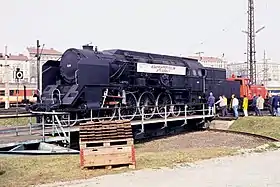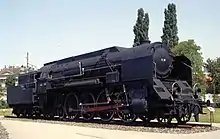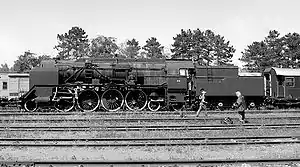BBÖ 214
The BBÖ 214 were a class of 13 Austrian 2-8-4 express train steam locomotives of the Federal Railways of Austria (Bundesbahnen Österreich, BBÖ). They were the largest steam locomotives ever built in Austria and the most powerful express locomotives with the longest connecting rods that existed in Europe at that time. To date, the 214 has the longest connecting rods in the world. During test runs, a locomotive reached a speed of 155 km/h.
| BBÖ 214 CFR 142 DRB 12 ÖBB 12 | |
|---|---|
 BBÖ 214-ÖBB 12 | |
| Number(s) |
|
| Quantity | 13 |
| Manufacturer | Lokomotivfabrik Floridsdorf |
| Year(s) of manufacture | 1928–1936 |
| Retired | 1961–1962 |
| Wheel arrangement | 2-8-4 |
| Axle arrangement | 1′D2′ h2 |
| Track gauge | 1,435 mm (4 ft 8 1⁄2 in) |
| Length over buffers | 22,580 mm (74 ft 1 in) |
| Height | 4,650 mm (15 ft 3 1⁄8 in) |
| Width | 3,150 mm (10 ft 4 in) |
| Empty weight | 107 or 114 t (105 or 112 long tons; 118 or 126 short tons) |
| Service weight | 118 or 123.5 t (116.1 or 121.5 long tons; 130.1 or 136.1 short tons) |
| Service weight incl. tender | 178 or 183.5 t (175.2 or 180.6 long tons; 196.2 or 202.3 short tons) |
| Adhesive weight | 72 t (71 long tons; 79 short tons) |
| Axle load | 18.0 t (17.7 long tons; 19.8 short tons) |
| Top speed | 110 or 120 km/h (68 or 75 mph) |
| Indicated Power | 2,940 PS (2,160 kW; 2,900 hp) |
| Starting tractive effort | 200 kN (45,000 lbf) |
| Driving wheel diameter | 1,940 mm (6 ft 4 3⁄8 in) |
| Carrying wheel diameter | 1,034 mm (3 ft 4 3⁄4 in) |
| No. of cylinders | 2 |
| Cylinder bore | 650 mm (25 9⁄16 in) |
| Piston stroke | 720 mm (28 3⁄8 in) |
| Boiler Overpressure | 15 kgf/cm2 (1.47 MPa; 213 lbf/in2) |
| Grate area | 4.72 m2 (50.8 sq ft) |
| Superheater area | 91.00 m2 (979.5 sq ft) |
| Evaporative heating area | 258 m2 (2,780 sq ft) |
| Tender service weight | 60 t (59 long tons; 66 short tons) |
| Water capacity | 29.5 m3 (6,500 imp gal; 7,800 US gal) |
| Fuel | 8.0 t (7.9 long tons; 8.8 short tons) of coal |
| Transmission | 2-cylinder simple superheated |
| Train brakes | Air brake |
| Train control | Heusinger (Walschaerts with Lentz valves |
| Couplers | Buffers and chain coupling |
History
In 1927, the board of the BBÖ decided to temporarily stop electrification. In the course of this very controversial decision, it was also decided to purchase new steam locomotives for the Westbahn, which should be so powerful that they could achieve the same travel times with heavy express trains between Vienna and Salzburg as would have been possible with electric operation. Of the two prototypes, 114.01 (three-cylinder engine, delivered in 1929) and 214.01 (two-cylinder engine, delivered in 1928), the 214 series was finally selected for further construction. In 1931, Lokomotivfabrik Floridsdorf built six locomotives, and in 1936 built another six with technical modifications. The Romanian State Railways (Căile Ferate Române, CFR), or more precisely Reșița works or Nicolae Malaxa in Romania, acquired a license from Floridsdorf and built 79 units with minor changes, which were given the series designation 142 by the CFR.
The new locomotives were used in the express train service between Vienna and Salzburg or Passau. After being taken over by the Deutsche Reichsbahn in the wake of the annexation of Austria to the German Reich, they were referred to as the class 12 and now used as far as Regensburg. After 1945, the ÖBB kept the series 12 designation for the locomotives.
After the electrification of the Westbahn, this powerful type was no longer suitable for use. Some machines were transferred to the Südbahn in 1953 and used between Vienna and Villach. The different conditions, in particular the tight curve radii and steeper gradients on the Semmering, quickly became noticeable in heavy wear, so that the last journey at the head of an express train took place as early as 1956. In the expectation of finding a buyer for these locomotives, some of which were only 20 years old, they were initially stored in warm storage in the Vienna area. The progressive electrification of the main lines in neighboring countries made the purchase of steam express locomotives unnecessary and so the locomotives were scrapped in 1961 and 1962.
Preserved locomotives

The 12.10 was the only one that remained for posterity. It was left to the Austrian Railway Museum and initially stored in a sheltered boiler house. In the 1970s it was erected as a memorial together with other historically significant steam locomotives (including the 310.23) in a locomotive park at the Vienna Technical Museum. After the locomotive park was closed as part of a restructuring of the Technical Museum, it was transferred to the Strasshof Railway Museum in Lower Austria in 1999, where it was exhibited as a non-operational exhibit. On October 19, 2018, the locomotive was moved by heavy transporter to Korneuburg. The external restoration began there, and in 2019 it was originally supposed to be exhibited in Wiener Neustadt as part of the state exhibition.[1][2] However, since the 12.10 is not a Wiener Neustädter Lokomotivfabrik locomotive, it was ultimately dispensed with. It was transferred to the Technical Museum in Vienna in October 2019[3] and has been open to the public again in the West Hall since September 2020.[4]
In 1985 the Austrian Society for Railway History (Österreichischen Gesellschaft für Eisenbahngeschichte, ÖGEG) succeeded in acquiring the locomotive 142.063 from the CFR, which was a license replica of the 214 series machines from 1939. It was adapted to the Austrian equipment and after restoration and general inspection in 1993 it was put back into operation with the (fictitious) number 12.14. It is now based in Ampflwang, but has not yet been returned to service after the boiler ticket expired and can currently be viewed partially dismantled (as of 2019).

| Number | Build year | Status | Owner / location | Notes |
|---|---|---|---|---|
| ÖBB 12.10 | 1936 | non-operational | Vienna Technical Museum | |
| CFR 142.063 | 1939 | non-operational | ÖGEG / Ampflwang | Displayed as "12.14" |
At least three other copies of the Romanian 142 series have been preserved in Romania.
References
- "Strasshof: Dampflok weg: Museum sauer. (Article from 24 October 2018)". NÖN (in German). Retrieved 24 October 2018..
- "Strasshof: Totales Chaos wegen Dampflok. (Article from 20 February 2019". NÖN (in German). Retrieved 21 February 2019.
- "Die Lokomotive kehrt zurück". Vienna Technical Museum (in German). Retrieved 2019-11-13.
- "Die 12.10". Vienna Technical Museum (in German). Retrieved 2020-09-02.
- Giesl-Gieslingen, Adolph (30 March 1929). "Die 1D2-Heißdampf-Zwillings-Schnellzuglokomotive R 214 der Österr. Bundesbahnen". Zeitschrift des Vereines deutscher Ingenieure (in German). 73 (13): 441–442.
- Seidl, Oskar (16 November 1929). "Die 1D2-Drillings-Schnellzuglokomotive der Österreichischen Bundesbahnen". Zeitschrift des Vereines deutscher Ingenieure (in German). 73 (46): 1641–1643.
- Zoubek, Dieter (2004). Erhaltene Dampflokomotiven in und aus Österreich (in German). Eigenverlag. ISBN 3-200-00174-7.
- Giesl-Gieslingen, Adolph (1981). Die Ära nach Gölsdorf (in German). Vienna: Verlag Slezak. pp. 204 et al. ISBN 3-900134-37-5.
- Giesl-Gieslingen, Adolph (1974). "Die österreichischen 1D2-Schnellzugslokomotiven Reihe 214/114". Lokmagazin (in German). No. 65/66. Franckh´sche Verlagshandlung.
- Journal Die Lokomotive. 1) issue 1/1929 2) issue 4/1929 3) issue 1/1932 4) issue 3/1937.
- Altmann, Brian; Reed (1972). Austrian 2-8-4s. LOCO PROFILE. Windsor, Berkshire: Profile Publications.
- Blieberger, Johann; Pospichal, Josef (2014). Dampfgetriebene Triebfahrzeuge der österreichischen Staatsbahnen ab 1945, Band 1 (in German). bahnmedien.at. ISBN 978-3-9503304-8-9.
- Ortner, Martin (2018). Schnellzugdampflokomotiven der BBÖ-Reihen 114 und 214, Band 1: 1929 bis 1945 (in German). Railway-Media-Group. ISBN 978-3-902894-51-9.
External links
- "BBÖ 214 / CFR 142 / ÖBB 12". Austrian Steam base (dampflok.at).
- "The Railfaneurope.net Picture Gallery". railfaneurope.net.
- "Lokpark Ampflwang". ÖGEG (in German).
- "Die 12.10 eine Dampflokomotive der superlative". Vienna Technical Museum (in German).